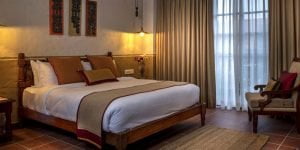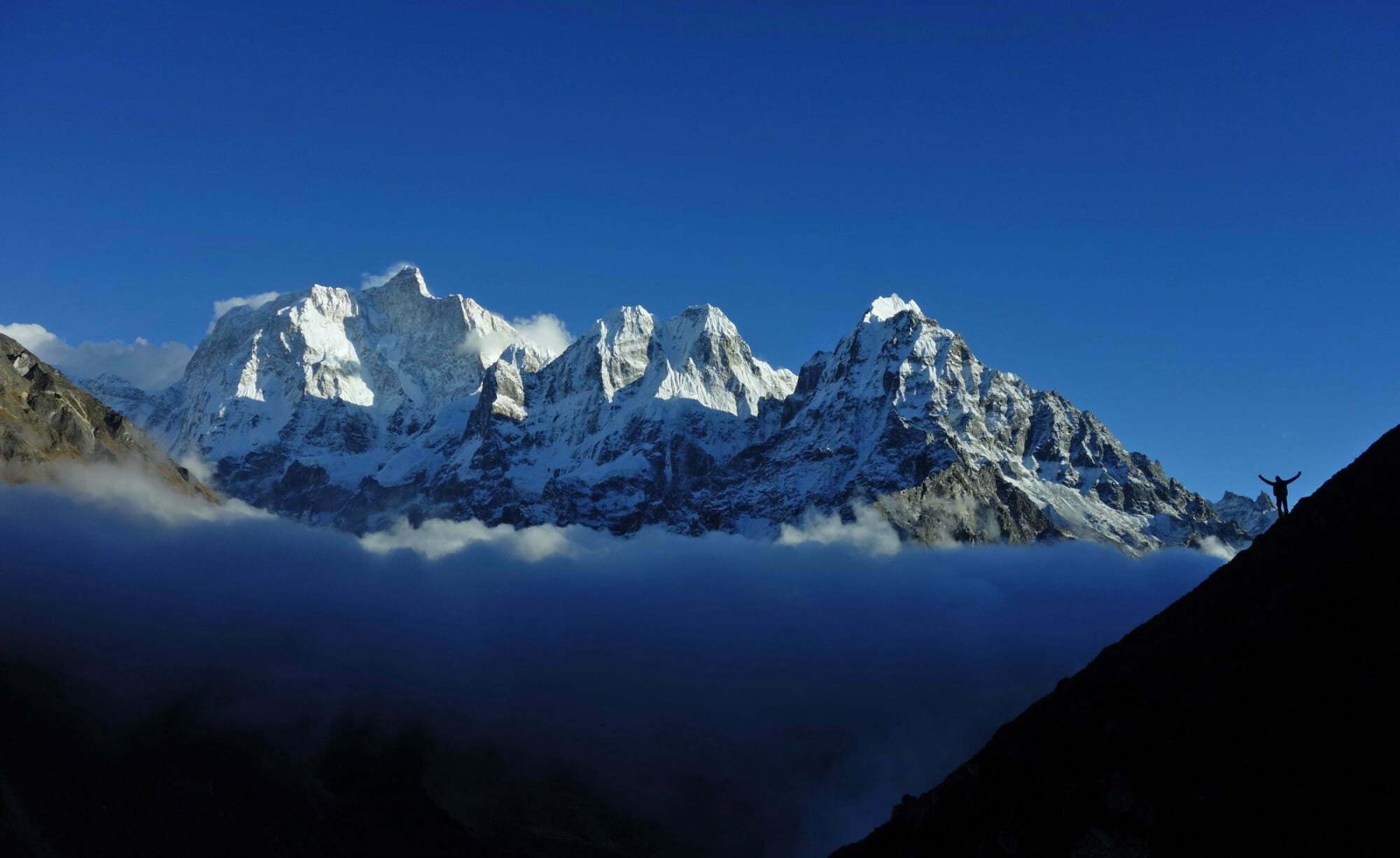Kanchenjunga
Base Camp
26 Days 5700 ex Kathmandu
Accommodation
5 Nights Hotel Stay
20 Nights Tea House

Transportation
Mostly on foot
Transfers and flights included
1 Porter 1 Trekker Policy

Included Meals
25 Breakfasts
22 Lunches
23 Dinners
All Open Menu Your Choice
Trip Grade
Category 4
Extreme Expedition – Cold
My friend summited Everest a few years ago. When I told him I was heading to Kanchenjunga, his eyes began to twinkle. While hundreds of climbers set out each year to reach the top of Everest, snowstorms, avalanches, and unpredictable weather deter all but a handful of select adventurers to this Himalayan region. Kanchenjunga is one of the world’s most challenging climbs; India’s highest peak is filled with obstacles for the most experienced mountaineers.
Even before our group leaves Kathmandu, it becomes clear to me this will be a journey like no other: colors seem more vibrant, and days are punctuated by sound of pujas, religious ceremonies conducted by Hindus and Buddhists alike. Bells ring, gongs sound, and as we depart denser urban areas, the landscape grows unmarred by development. Few places in the world seem so blissfully desolate.
Though our days are filled with challenging stretches, villagers welcome us into their homes for comforting mugs of tea and heaps of steaming rice. Men and women in traditional garments haul loads up and down long stretches of trail, and without warning, children appear, huge grins on their faces and their hands folded in “Namaste” greeting. In many areas throughout Nepal, foreheads are marked with red powder, but in this part of the country, holidays are celebrated in Buddhist tradition, with milky white blessings made from rice and yogurt. The languages spoken here are also unique, as people are descendants of Tibet, Nepal, and India. As a result, the culture is a fascinating weave of religion and tradition. Our pace allows us time to acclimatize to the thinner air and enjoy the local culture along the way.
Because this trek is located in Nepal’s eastern region and requires a longer itinerary to explore, it wasn’t until recently that guest houses began to operate. Accommodations are rustic, as fewer travelers make their way into these lands, but at night friendly faces open their guesthouse doors to our group. It’s become one of my favorite activities to gaze up at the blankets of stars appearing behind smoke rising from village fires.
In 1923, George Mallory, the dashing alpinist and writer, was asked by a New York Times reporter why he wanted to climb Everest. He famously replied, “Because it’s there.” The rest of his response is less commonly cited, but more instructive.
“Everest is the highest mountain in the world. its existence is a challenge. The answer is instinctive, a part, I suppose, of man’s desire to conquer the universe.”
Everest Base Camp is established on the Khumbu Glacier which flows down the valley at about 1 meter per day. As such, mountaineering campsites need to be constantly constructed and deconstructed to accommodate for this movement.
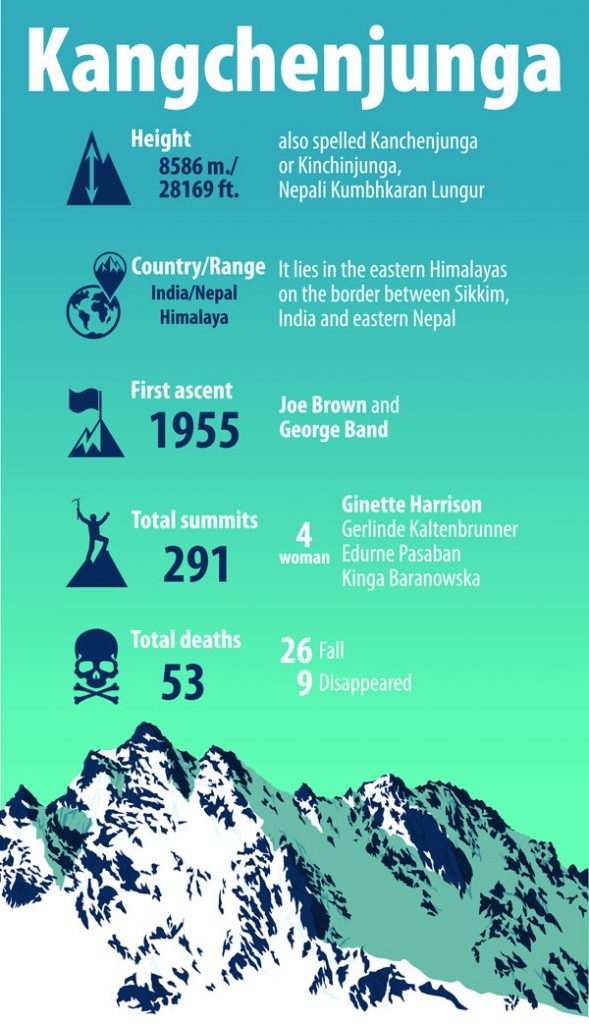
I learned quickly that dal bhat — rice, lentil soup, and curried vegetables — is the meal of choice for local people. I watch women choose vegetables fresh from their garden and offer us generous servings — a filling meal after a long day facing the elements. I’ve also grown to love thukpa, a brothy Tibetan noodle soup, and tsampa, roasted barley flour mixed with butter and sugar.
Along the way, we walk past prayer wheels and Buddhist prayer flags that drift from rooftops. Chopped wood is stacked high in anticipation of heavy winters. But with all of these interesting cultural scenes, it is hard not to marvel at the 8,586m peak of Kanchenjunga. The massif is impressive, and it is no wonder this peak holds special significance to the people who live here.
Pack your taste for adventure and get your fitness ready: travelers who journey to this part of the world are well rewarded.
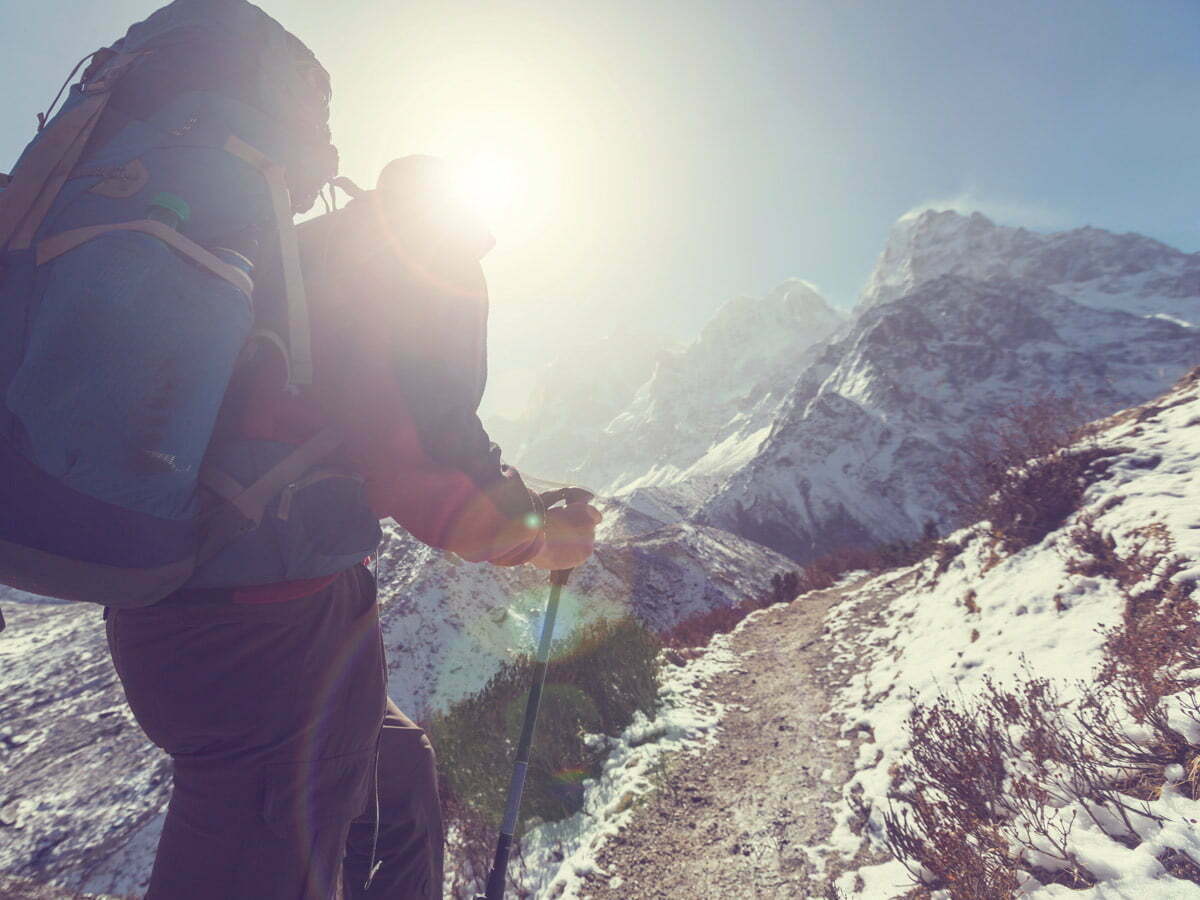
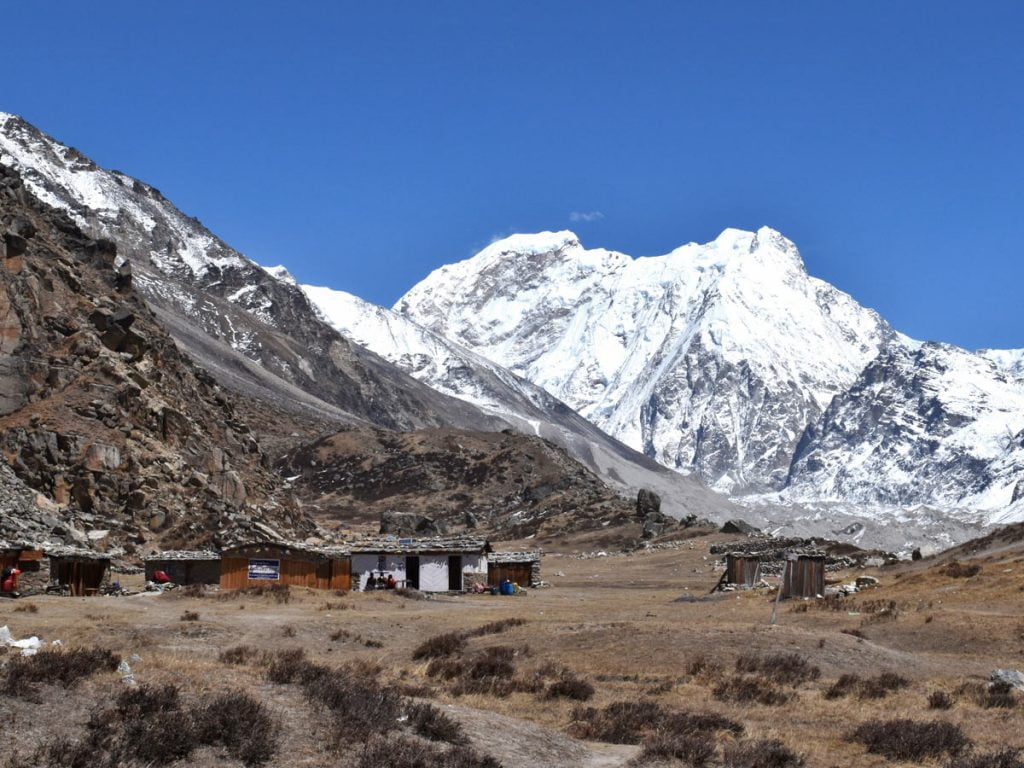
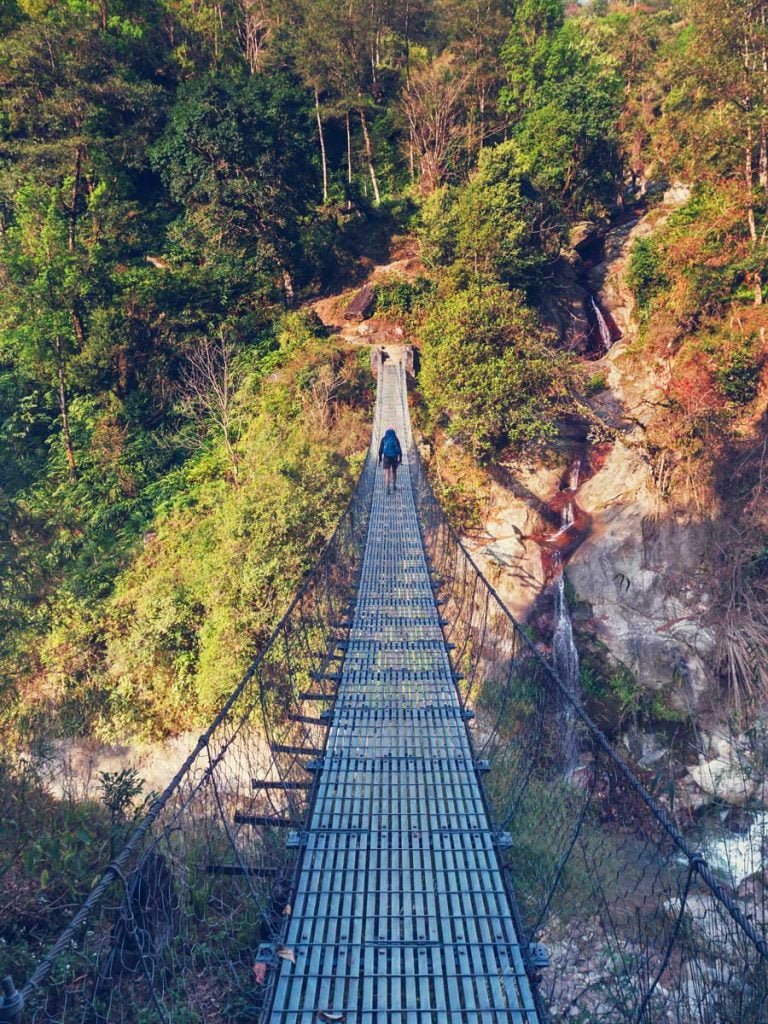
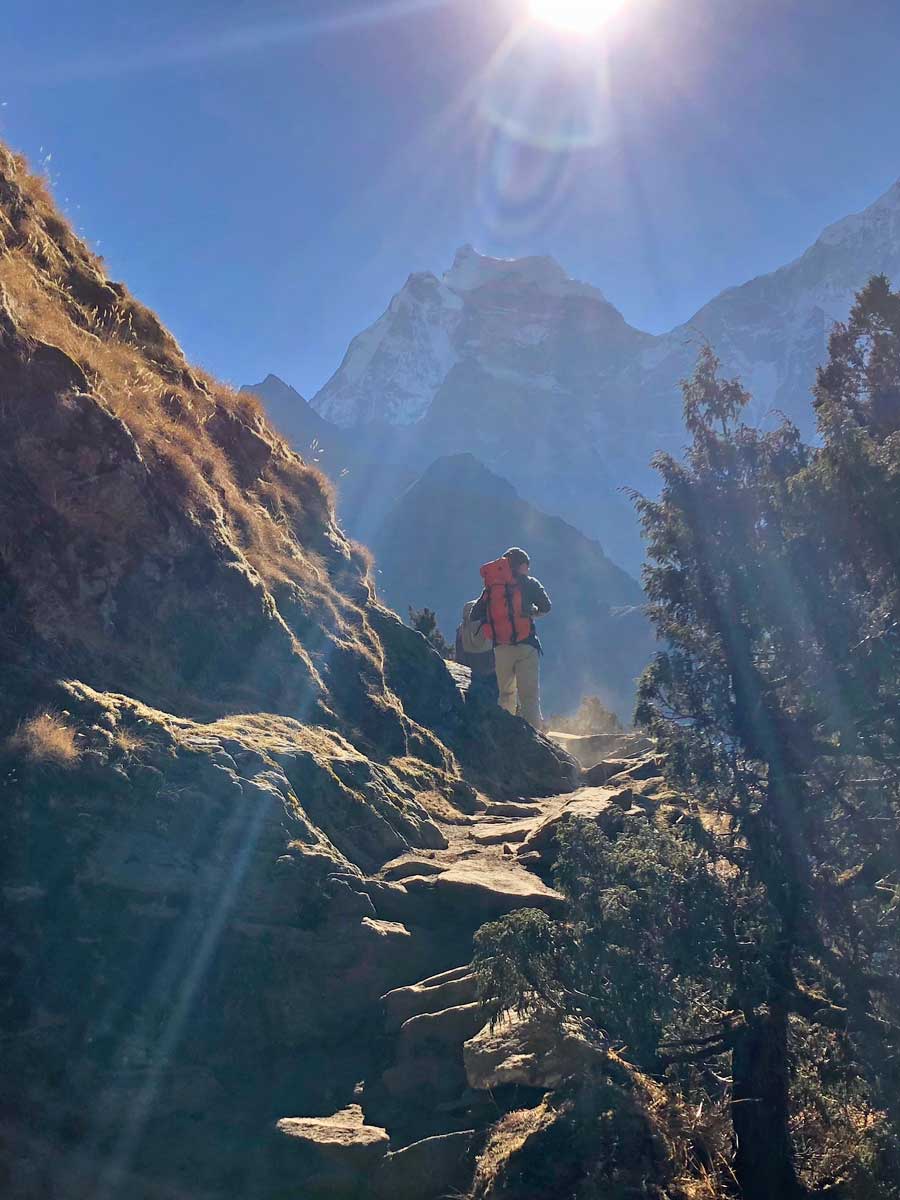
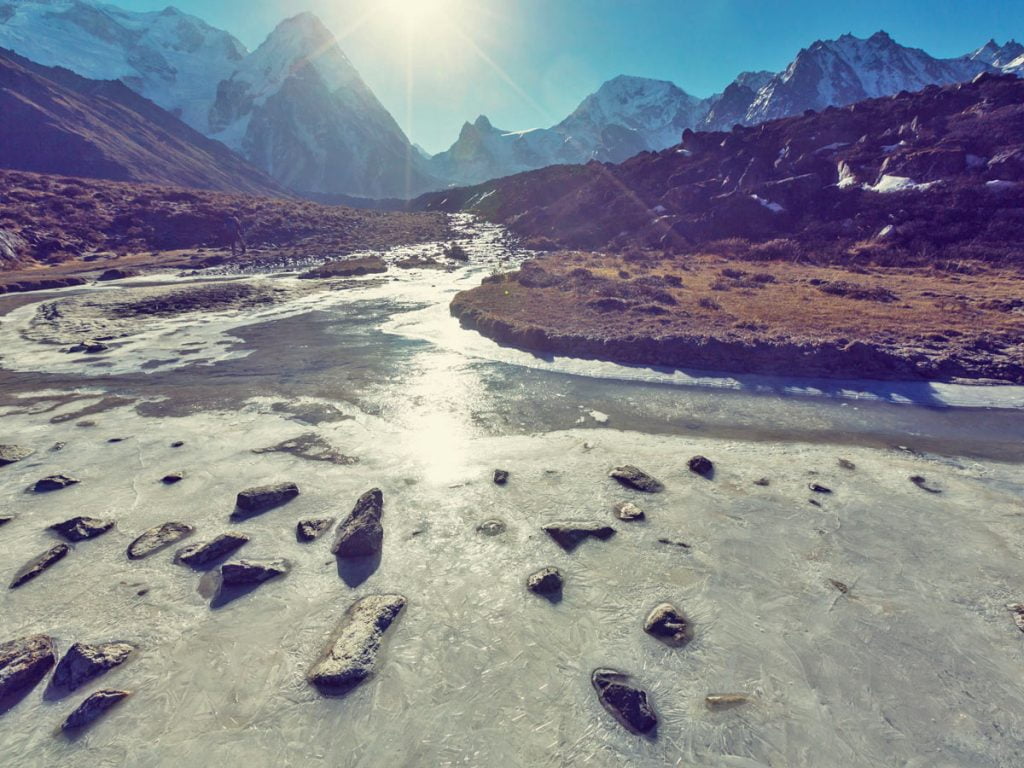
The Journey
You will be met at the airport and transfer to the hotel, where our pre-trek briefing and other information will be given. All the arrangements are made today for the distribution of your kitbag, down jacket, sleeping bag etc. The remainder of the afternoon is free. Your guide will be happy to assist you in any way he can and will meet you every day while you are in Kathmandu to help you with any queries. The evening will be highlighted by a traditional Royal Nepali cuisine as a perfect end of the first day. (D)
Today you will have time to explore the Kathmandu-valley, which has more World Heritage sites than any other city in the world. After the guided tour, the afternoon is free to pack, purchase last minutes items for your trek or simply relax. (B)
We fly to Biratnagar. The 45-minute flight provides excellent views as we head eastwards across Nepal. In clear weather, the panorama stretches from Ganesh Himal (7406m.) in the west to our first view of Kanchenjunga in the east. We spend the afternoon here and overnight in a hotel ready for our flight to Taplejung in the early morning. (B,L,D)
From Biratnagar we take a short connecting flight to Taplejung located close to the village of Suketaar. Here we will meet our trekking crews upon arrival and have lunch, with views of Kanchenjunga (8586m.) before descending to Mitlung and then to the Ghunsa Khola. From Thawa, we continue upstream, crossing a couple of landslides to reach the village of Chirwa (1530m.) in the early afternoon. Our campsite is in a large open field. Overnight Tea House. (B,L,D)
We descend down following the terraced fields into the Uttis (Nepalese elder) forest with cardamom plantation for about 45 minutes. We will cross the suspension bridge over a small river. From there again we climb about another 45 minutes and reach the top where there is a resting place. From there the trail is easy with terraced fields and Palas trees before climbing again. We cross another suspension bridge and reach a village called Yamkhia where we have lunch. After lunch, we will follow terraced fields along an undulating trail. From here we walk about 2 hrs to the village of Chiruwa. Overnight Tea House. (B,L,D)
Starting with a gradual climb we reach Sisawa after an hour or so. After crossing a small suspension bridge we continue on the east bank, passing the village of Thapethok. The walking remains easy through rice paddies until we reach a sheltered glade of Chilauney trees for lunch at Tapnawa Khola. In the afternoon it is a steady climb heading into the forest until we meet the junction of the Tamur and Walungchung rivers. From here there are views of the high peaks, a taste of things to come. Overnight Tea House Sakathum. (B,L,D)
Today we climb up the sides of a steep V-shaped valley. The trail zig-zags up through terraced slopes and passes the Tamang settlement of Ghaiyabari. From here we continue to climb steeply to pass a large mushroom-shaped rock. We take lunch a few minutes further on, near a small stream. In the afternoon, we continue to climb. The rest of the afternoon’s walk is gradual climbing and contouring past a beautiful 150-meter high waterfall before arriving at Amjilasa and our evening’s Tea House.. (B,L,D)
An easier day starting with a short climb through terraced fields before descending into a forest of bamboo, rhododendron, prickly and silky oak. The trail is now only a few hundred meters above the river and we leave behind the terracing that has dominated the trek so far. Lunch is taken early in the shade of overhanging cliffs. As it is only a short day we have ample time to wander up the trail admiring the scenery. As we are near Kyapra, some of the lesser peaks come into view at the head of the Ghunsa Khola. Overnight Tea House. (B,L,D)
For the time being, we have finished trekking across the grain of the land. From here on, up to the base of Kanchenjunga, our trails climb following the Ghunsa Khola through a forest of Birch and Rhododendron. The first settlement we reach is at Phole, populated in the main by Tibetan refugees. The village has an interesting monastery and is well known for its home-based carpet industry. We schedule lunch at the village to allow plenty of time for looking around. From here to the Tea House at Ghunsa is about one and a half hours. (B,L,D)
Ghunsa is the main village of the valley and we allow a full day to explore or relax as part of our acclimatization to the higher elevation. There is a chance to sample ‘Tongba’, the local brew of millet. (B,L,D)
We leave Ghunsa on a level trail through cultivated fields before entering a forest of Birch, Junipers and Rhododendron. The valley floor is now wider as we enter glacial terrain. Steep cliffs line the way with occasional views of Khabur peak (6332m.). After crossing the river at Rambuk Kharka, we take lunch before crossing the tricky scree slopes that lead the way to Khambachen. Nearing camp we get our first good views of Jannu and the Shaphu peaks. We stay overnight at Khambachen, a small temporary settlement, inhabited by yak herders mainly from Ghunsa. (B,L,D)
The early morning affords good photographic opportunities. We are now above the tree line and the slopes of the bare mountains are home to blue sheep that can sometimes be seen on this days walk, though they are not easy to spot. The trail is less well defined and at times it can be tricky, particularly when crossing the many tributary streams. We lunch at Ramtang in full view of Kanchenjunga. The scenery is certainly the most spectacular so far. In the afternoon we reach the snout of the Kanchenjunga glacier. Our Tea House is a short distance further on in the large yak grazing pastures of Lhonak. We will spend a further day acclimatizing here. (B,L,D)
We are now at quite a high altitude. It is necessary to take our time and proceed slowly. However, this section of the trail is surrounded by dramatic scenery. To the right of the trail the huge creaking glacier, lined by stunning ice peaks; at the head of the valley more peaks forming the India/Nepal border. Kanchenjunga, the world’s third-highest peak is initially tucked away and out of sight and it is not until we arrive at Pangpema that we get views of the towering north face. We will have lunch here, and stay overnight. The whole afternoon is free for relaxation or exploring the area. (B,L,D)
Today’s plan is to rise early for an exploration of the area before taking a late lunch and then heading down back down to Lhonak. For those feeling energetic, they will have the chance to climb Cocks Comb (though to reach the summit involves a good three-hour climb and is only recommended to those feeling very fit). As the views of Kanchenjunga are as impressive from our campsite or from only a few hundred meters above our camp, everyone has the opportunity to enjoy some excellent photographic opportunities. In the afternoon our walk takes us back down the valley to Lhonak and on to Khambachen where our crew will be waiting for our arrival. (B,L,D)
We retrace our steps down the valley where we have the opportunity to get excellent photographs of Jannu. We will overnight in Ghunsa in preparation for the following morning’s uphill walk. (B,L,D)
After checking our trekking permits at the police post, we will head through a series of boulder fields before gaining a steep ridge that leads us out of the Ghunsa valley. The climb takes us through thick Birch and Rhododendron forests, the best on the trek. The trail here is not well defined. At the Tagmalasi pass (4935m.), the trail evens out and gives great views both up and down the Ghunsa valley. Soon we climb above the tree line and continue on a series of ups and downs high above the valley. We take a packed lunch today as there is little water on this trail. There are excellent views towards Makalu and Everest from our Tea House. (B,L,D)
Today’s walk is particularly exciting with superb mountain views initially of Everest and Makalu, as we climb and then Jannu and Kanchenjunga come into view. It takes about two hours to cross the Mirgin La pass at 4610 meters which takes us into the Simbua river valley. We are well above habitation and the tree-lines. The trail is clearly defined through this barren terrain. After lunch, we cross another pass above Tseram and gain great views looking northwards to Kabru Peak (7353m.) and Rathong (6678m.). The descent into the valley is steep, via a small lake to our Tea House at Tseram. (B,L,D)
The track gradually climbs up the valley via Ramche, a yak herder’s settlement, before bearing left and ascending onto the lateral moraines to give excellent views of Kabru and Kanchenjunga. Ramze is a high altitude Tea House, but it is well worth the visit. Here we will see the glacier Okthang (4750m.) with incredible views of the southern aspect of Kanchenjunga. (B,L,D)
We descend following the Simbua Khola. The landscape begins to change again from high altitude vegetation back into forests of Rhododendron, Fir and Cedar. The valley becomes narrower as we descend. At Hellok we cross the river and take lunch beside the wooden bridge. In the afternoon we climb steadily through the forest of Oak, Rhododendron and bamboo to the Lase pass (3480m.), high above the valley. Our Tea House is ten minutes further on with views of Jannu to the north. (B,L,D)
The day starts with a steep descent through a forest where many water buffalo graze. Here we take lunch before climbing to a small saddle (2660m.) adorned with prayer flags. We descend from here. Past the first permanent habitation seen for a number of days to the village of Yampudin. We check in to our Tea House near the river in the early afternoon and have the opportunity for a swim in the cool water. (B,L,D)
From the village, we walk downstream following the Kabeli Khola passing occasional Rai and Limbu’s settlements before climbing out of the valley to begin a series of small ascents and descends through terraced hillsides. Our trail continues via the small village of Dekadin to the much larger settlements of Mamankhe. Overnight Tea House. (B,L,D)
We start with a gradual but then steep descent to the Khesewa Khola which we cross on a suspension bridge. The route then winds uphill through terraced hillsides and various small settlements to reach the ridge at Ponpe Danda, where there are good views of Jannu Himal. We descend again to Anpan village and continue high above the river in a series of short ascents and descents through a beautiful forest before reaching the Nandeva Khola, from whence we descend to our Tea House at Sinchena pass. (B,L,D)
From our campsite, we descend to Khesewa, the peaks of the Kanchenjunga massif behind us in the distance. We take lunch close to the bridge, crossing the Phawa Khola. In the afternoon, we descend to Simbu (1707m.) and then continue uphill through a forest of Oak to the shepherd’s huts below the pass which provides views of Makalu to the west. (B,L,D)
We descend to Tambawa village (1990m.); from here we have a further descent on a ridge route to the airfield at Sukhetaar above Taplejung village. A final night with our crew is spent here in celebration of one of Nepal’s best treks. (B,L,D)
In the morning we await the arrival of our shuttle aircraft to take us to Biratnagar. Our flight to Kathmandu is usually in the late afternoon taking approximately 45 minutes. On take-off, we should gain views of some of the places and rivers and mountains which have been our companions for the last three weeks. From Kathmandu airport, we transfer to our hotel. (B)
Today, sadly, you head home.
Note: The above route and walking hours must be seen as a guide only. This itinerary may change at any time due to weather, trail conditions or other reason.
Includes
- Arrival and Departure transfers on both domestic and international flights.
- 3 nights accommodation at Harati Manor Hotel twin share
- OPEN and CHOICE of Full board meals while on expedition.
- One Trekker: One Porter Policy
- Accommodation at clean and comfortable tea houses or lodges.
- Welcome dinner with the cultural program as listed in the itinerary.
- Half day guided city tour with world heritage entrance permit as listed in the itinerary.
- All Domestic flights and airport tax.
- Private transportation to and from the starting and ending points of the trek as applicable.
- Free use of quality trekking gear – sleeping bag, fleece liner, down jacket, rain poncho.
- Professional local trek leader with Wilderness First Aid.
- Portable Altitude Chamber (PAC) / Gamow Bag (A life-saving device in case of Acute Mountain Sickness) along with a comprehensive First Aid Kit.
- Assistant trekking guides and other support staff for Everest base camp trek.
- Trekking map.
- Personal Sherpa Porters to carry all personal gear.
- Insurance of all staff including Porters.
- Warm clothing and required trekking gear for Porters like Gortex jacket /trousers, trekking shoes, woolen hat, woolen gloves, woolen shocks, sunglasses etc.
- Complimentary souvenir Tshirt.
- TIMS Trekking permit
Excludes
- International flights
- Insurance
- Tips and beverages
Journey Extensions
Check out our Journey Extensions for those that want to stay a little longer or try something different along the way.
In the heart of Thamel, is the Nepali Ghar Hotel. The Nepali Ghar punctuates the new trend of modern hotels and breezes an ode to Nepalese traditional styles. These traditions afford a warm and homely environment for all adventurers. The hotels Delux rooms are luxurious and open with excellent facilities. The hotel has a restaurant that serves great food as well as a fitness centre.
If you would like to stay at the Nepali Ghar Hotel as part of your package of 2 nights before and 1 night after an expedition the extra price will be $550 (for all 3 nights).
For twin rooms where you share the room, the price is $300 per person twin share.
In the heart of Thamel, is the Nepali Ghar Hotel. The Nepali Ghar punctuates the new trend of modern hotels and breezes an ode to Nepalese traditional styles. These traditions afford a warm and homely environment for all adventurers. The hotel’s Delux rooms are luxurious and open with excellent facilities. The hotel has a restaurant that serves great food as well as a fitness centre.
If you would like to stay at the Nepali Ghar Hotel as part of your package of 2 nights before and 1 night after an expedition the extra price will be $300 per person twin share (for all 3 nights).
For single rooms for these nights the extra price is $550.
“Hi No Roads, just a quick thank you for the amazing experience I’ve just had in Nepal on the Everest Base Camp trek. Everything was spot on, from the quality of the Kathmandu hotel, the trekking equipment provided to the top quality meals along the way in the tea houses. But most importantly, I was very impressed with the expertise of the local guides (when you have a Sherpa who has successfully climbed Mt Everest twice, you know you’re in good hands), their care of the group and advice about high altitude, what to expect and little hints on how best to acclimatise assisted in getting our whole group to EBC in one piece.”
Hadyn, Australia
Trek responsibly with trained porters and guides
Our team are committed to making sure your journey is a safe and memorable one. Each guest is paired with one porter (we have a 1 Porter 1 Trekker policy) to ensure a comfortable trek, and all of our guides receive medical and mountaineering training to make sure your experience is pleasant. We provide safety equipment and bring necessary medical supplies on each trip.
Enjoy local and cultural experiences with our knowledgeable team
With side excursions to monasteries and farming villages, we take our guests on trails less travelled by other climbing companies. Along the way, our footsteps will cross the shadows of Ama Dablam as our bodies adjust to higher elevations and more rugged terrain. Returning home, we’ll travel down a different route that allows us to encounter ancient Tibetan rituals at the Buddhist Thyanboche monastery.
Prepare for an adventure of a lifetime
Before we begin our trek, our team will review our itinerary to Lukla and answer your questions about what to expect in the days leading to your Gokyo and Everest Base Camp trek. The Dudh Koshi River has carved a natural trail for us to follow as we hike towards the picture-perfect village of Namche Bazaar. We’ll spend several nights adjusting to the altitude before making our way into the hidden valleys of Khunde and Khumjung. From there qwe depart the normal route to Everest Base Camp and head northwest toward Gokyo. This is a very high altitude section where we will be sleeping well 4500 meters for several nights and trekking passes in excess of 5000 meters. We will rejoin the main Everest Base Camp trail after we cross the Cho La and head toward Gorak Shep to prepare for our final ascent to see the ice-blue Khumbu glacier. Your stamina will be tested as we wake before sunrise to climb Kalapathar, a peak resting at 5545 meters above sea level. Here, the first rays of the morning will paint mountaintops copper and gold, and we’ll bask in the breathtaking beauty of the Himalayas. This is truly a moment you’ll never forget.
We get asked a lot of questions about the Everest Base Camp Gokyo Lakes trek. The following are certainly the most common however if you have another question please let us know or the answer may be found in our Trip Notes section.
How hard is the Everest Base Camp via Gokyo Lakes trek?
This trek is a step up from the normal Everest Base Camp trek which is surprisingly not too difficult other than the altitude and weather. The Gokyo Lakes section has several very high sections and passes which makes trekking more difficult. You will need to train for this trek, to ensure your body is fit enough for these pass sections. The enemy on this trek is altitude. As such we need to take it slowly so our bodies acclimatise. We have 2 acclimatisation days on this trek where we spend the day hiking to a higher altitude, before heading back down for our bodies to recover.
Do I have to carry my own gear?
You do not have to carry you own gear all the way to Everest Base Camp. Our 1 Porter 1 Trekker policy allows us to carry all your gear for you during the day. Your bag will be at the tea house ready for you to freshen up at the end of the day. All you need to carry is a day pack which will have some wet weather gear in it such as the supplied poncho, possibly warmer clothes, water and sunscreen and some money. Usually the pack will weigh around 5kgs.
What are the Tea Houses like on the Everest Base Camp trek?
Your accommodation along the way will be the iconic Nepali Tea Houses. These Tea Houses are one of the highlights of the trip. We have handpicked what we think are the best Tea Houses along the trail to Everest. Warm and inviting, each Tea House consists of a communal hall with tables and chairs scattered around the perimeter and central to the room is the heater, which as the sun falls below the horizon becomes a focal point.
The Tea House serves up delicious food from Western staples such as fried potatoes to Nepali dal bhat. We have an open menu policy, so you can pick anything from the menu.
Bedrooms fan out from the main communal room either at the same level or upstairs. Bedrooms are usually basic and bathrooms are shared.
Each Tea House has its own history and are incredible places to stay, to fill our bellies, warm our hands and to meet other hikers from all over the world. Put simply, we love Tea Houses.
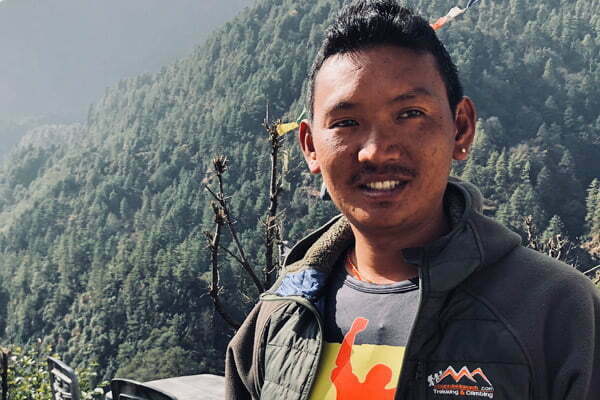
This trip is for those who want to get off the beaten trail, to Everest from a different angle, and who love adventure and at times pushing themselves to higher achievements. This is an incredibly beautiful hike, nestled in among the highest mountains on the planet. I love this trek and get excited every time I am asked to guide it.
Dawa
Nepal Guide


